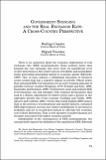Artículo
Government spending and the real exchange rate: a cross-country perspective
Fecha
2013Resumen
There is no consensus about the economic implications of real exchange rate (RER) misalignments. Some authors argue that keeping the real exchange rate away from its equilibrium level creates distortions in the relative prices of tradable and nontradable goods generating misleading signals to economic agents (Edwards 1989). This in turn induces a suboptimal allocation of resources across sectors that has a negative impact on growth. Others argue that sustained RER overvaluations are an early warning indicator of possible currency crashes (Krugman 1979 Frankel and Rose 1996 Kaminsky and Reinhart 1999). Furthermore large and medium RER overvaluations can end abruptly with nominal devaluations that lead to a drastic adjustment of relative prices and a decline in the aggregate growth rate of the economy (Goldfajn and Valdés 1999 Aguirre and Calderón 2005). On the other hand Rodrik (2008) argues that in the presence of institutional and market failures sustained RER depreciations increase the relative profitability of investing in tradables and act in second-best fashion to alleviate the economic cost of these distortions. That is why episodes of undervaluation are strongly associated with higher economic growth.
Colecciones
Descargar


